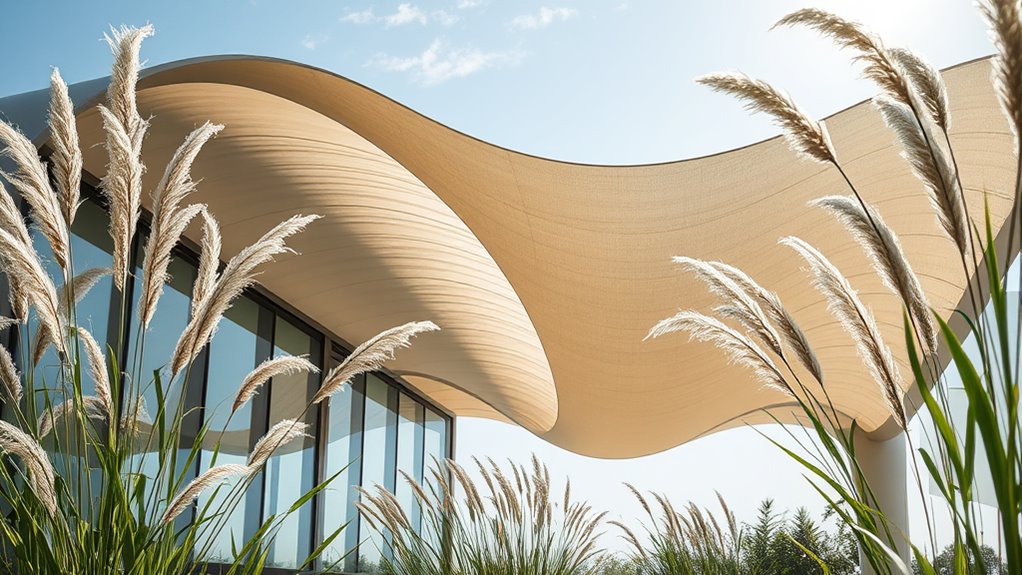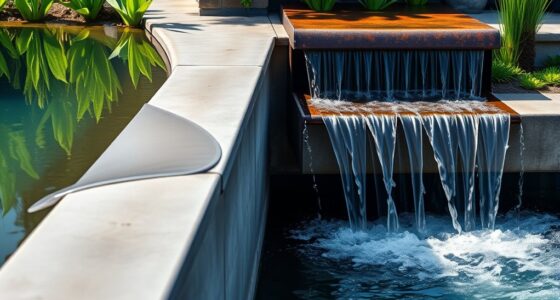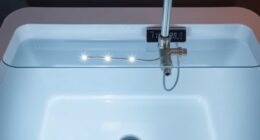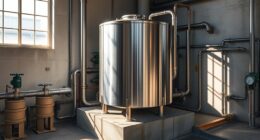When designing for breezes and gusts, you should understand local wind patterns and microclimates to optimize airflow. Use aerodynamic building shapes, strategic orientation, and placement of openings to enhance natural ventilation while reducing turbulence. Incorporate landscape features like trees and fences as windbreaks, and select materials and structural elements that resist wind forces. By applying these strategies, you’ll create resilient, comfortable spaces that harness wind benefits and minimize challenges—there’s more to discover on how to achieve this effectively.
Key Takeaways
- Analyze local wind patterns and microclimates to position openings and aerodynamic features effectively.
- Incorporate windbreaks, landscaping, and barriers to redirect gusts and reduce wind impact on structures.
- Design building shapes with rounded edges and streamlined surfaces to minimize turbulence and wind resistance.
- Use strategic orientation and placement of openings to enhance natural ventilation and airflow efficiency.
- Select durable, flexible materials and structural features that withstand gusts and prevent wind damage.
Understanding Wind Patterns and Their Impact on Structures
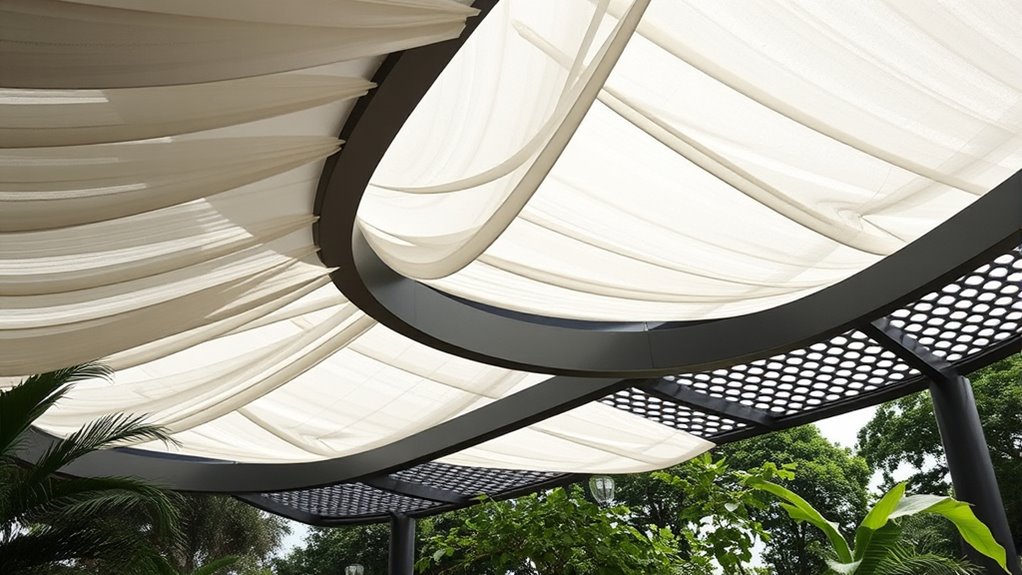
Understanding wind patterns is essential because they directly influence how structures respond to environmental forces. When you grasp how wind moves across different landscapes and elevations, you can better predict the forces acting on your building. Wind speed, direction, and turbulence vary based on geographic features like hills, open plains, or urban environments. Knowing these patterns helps you design structures that withstand gusts and steady breezes without damage or discomfort. For example, buildings in coastal areas face stronger, more unpredictable winds than those inland. Recognizing prevailing wind directions allows you to position openings and aerodynamic features most effective, reducing wind pressure on walls and roofs. Proper site analysis is crucial for understanding local wind behaviors and designing accordingly. Ultimately, understanding wind behavior helps you create safer, more resilient structures that adapt effectively to their environment.
Analyzing Local Wind Conditions and Microclimates
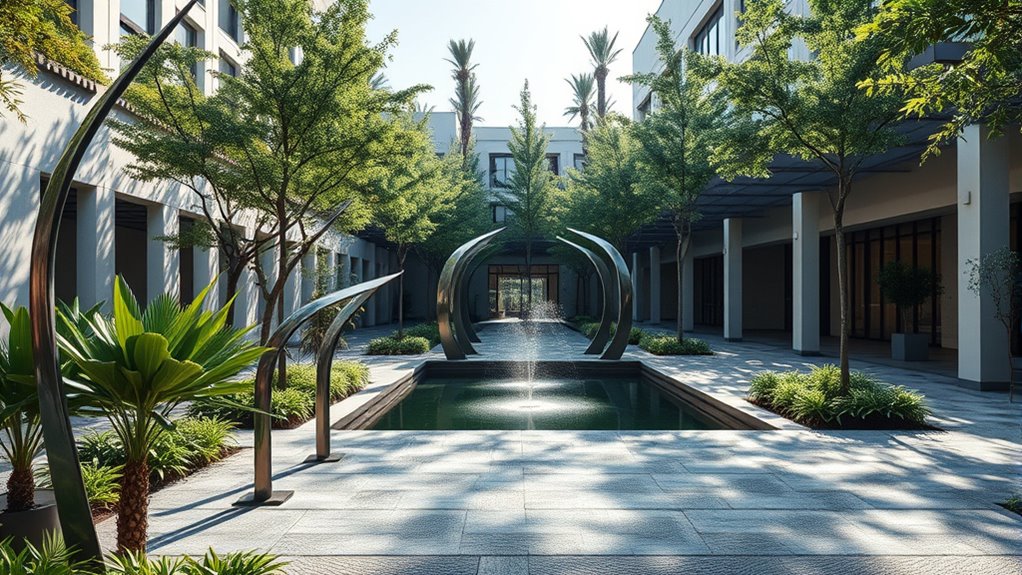
You need to examine local wind patterns to understand how they influence your environment. Evaluating microclimate factors helps identify areas with unique wind behaviors that affect comfort and safety. Recognizing seasonal wind variations ensures your design or planning accounts for changing conditions throughout the year. Monitoring signs of spoilage in outdoor environments can help anticipate unpredictable wind-driven changes that impact your space.
Local Wind Patterns Analysis
Local wind patterns are shaped by a complex interplay of terrain features, surface temperatures, and surrounding vegetation, creating distinct microclimates within small areas. To analyze these patterns, you need to observe how wind flows around buildings, hills, and open spaces. Use wind maps, anemometers, or local weather data to identify common directions and gust intensities. Pay attention to how structures channel or block breezes, causing acceleration or stagnation zones. Recognizing seasonal variations helps you anticipate changes in wind behavior throughout the year. By understanding these local patterns, you can design spaces that maximize breezes for cooling or reduce gust impacts, enhancing comfort and safety. Precise analysis allows you to tailor your design to the specific wind characteristics of your site. Incorporating data-driven strategies can further improve the accuracy of your microclimate assessments and optimize your design solutions.
Microclimate Influences Assessment
Building on your analysis of local wind patterns, evaluating microclimate influences involves examining how specific features like buildings, vegetation, and terrain alter wind flow and temperature. These elements create localized variations that impact comfort and airflow. For example, tall buildings can block or channel breezes, while dense vegetation provides windbreaks and shade. Terrain features like hills or valleys funnel or divert winds, affecting microclimates. Use this table to identify key influences:
| Feature | Effect on Wind and Temperature |
|---|---|
| Buildings | Block, redirect, or accelerate airflow |
| Vegetation | Reduce wind speed, provide shade |
| Terrain | Funnel winds, create turbulence |
Assessing these influences helps optimize design for breezes, ensuring comfortable, energy-efficient environments. Recognizing how microclimate influences vary with local features allows for more precise and effective environmental planning.
Seasonal Wind Variations
Seasonal wind variations considerably influence microclimates by altering airflow patterns throughout the year. You’ll notice that during winter, prevailing winds often come from colder, more stable directions, while in summer, breezes tend to shift, bringing warmer, more humid air. These fluctuations impact how heat and moisture move across your site, affecting comfort and natural ventilation. By analyzing local wind patterns seasonally, you can identify periods of increased breeze or calm. This knowledge helps you design spaces that maximize cooling during hot months and retain warmth in colder seasons. Understanding these variations allows you to position openings, shade elements, and vegetation strategically, creating a microclimate tailored to seasonal shifts. Incorporating seasonal wind data into your planning enables more precise adjustments for comfort and energy efficiency year-round. This proactive approach optimizes comfort and energy efficiency year-round.
Principles of Aerodynamics in Building Design
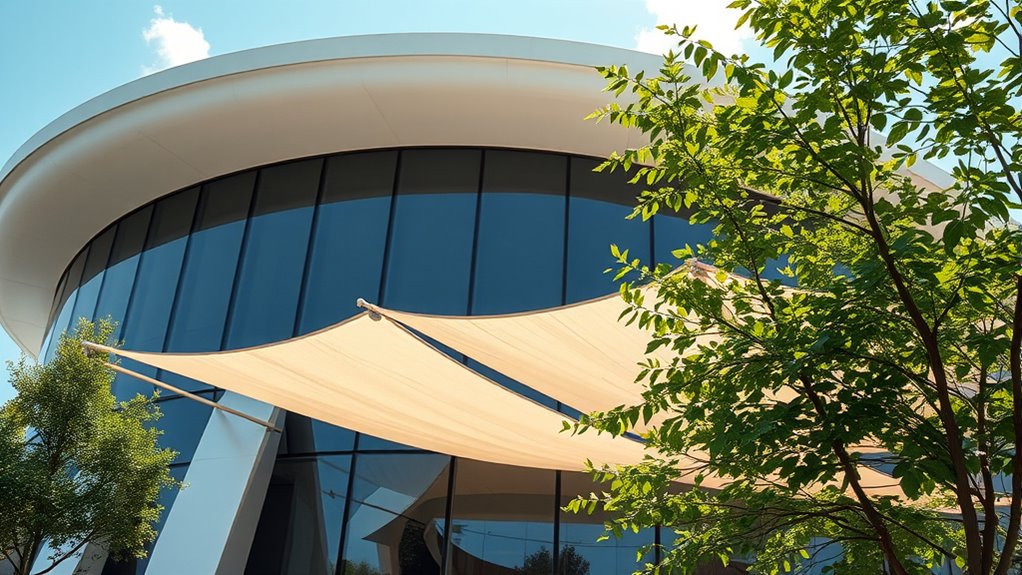
Understanding airflow optimization strategies helps you design buildings that minimize wind resistance and enhance stability. You’ll also need to contemplate pressure distribution dynamics to prevent structural issues and improve comfort. Mastering these principles allows you to create more aerodynamic, resilient structures. Additionally, considering airflow patterns can help optimize natural ventilation and reduce energy costs.
Airflow Optimization Strategies
Optimizing airflow around structures requires applying core principles of aerodynamics to minimize turbulence and improve ventilation. You should start by designing building shapes that encourage smooth airflow, avoiding sharp edges that cause turbulence. Incorporate aerodynamic features like rounded corners or streamlined surfaces to reduce drag and wind resistance. Position openings such as windows and vents strategically to promote natural ventilation and prevent stagnant air pockets. Use windbreaks or landscaping to guide breezes toward desired areas while shielding sensitive zones from gusts. Adjust building orientation to align with predominant wind directions, enhancing airflow efficiency. By focusing on these strategies, you create a more comfortable, energy-efficient environment that leverages natural wind forces rather than fighting against them.
Pressure Distribution Dynamics
Pressure distribution plays a crucial role in how wind interacts with building surfaces, affecting both structural integrity and airflow patterns. When wind hits a building, pressure varies across surfaces, creating areas of high and low pressure. You need to understand these dynamics to predict how wind forces will act on your structure. For example, high-pressure zones on windward sides push inward, while low-pressure zones on leeward sides cause suction, potentially leading to uplift or vibration. These pressure differences influence airflow around the building, affecting ventilation and comfort. By designing with pressure distribution in mind, you can reduce wind loads and improve stability. Strategic shaping and placement of openings help manage pressure variations, ensuring your building withstands gusts and breezes effectively. Additionally, considering the pressure distribution dynamics in your design can help optimize natural ventilation, reducing energy consumption.
Strategies for Enhancing Natural Ventilation and Breeze Flow

To effectively enhance natural ventilation and increase breeze flow, you should focus on designing building features that promote airflow. Incorporate large, operable windows positioned to catch prevailing winds, allowing breezes to flow through easily. Use cross-ventilation by placing openings on opposite sides of rooms to facilitate air movement. Incorporate vents at different heights, such as roof vents or vents near the floor, to encourage stack effect-driven airflow. Consider creating open floor plans that prevent barriers to airflow and reduce obstructions. Use landscaping strategically with trees or shrubs that direct breezes toward building openings. Additionally, design building orientations that align with local wind patterns, maximizing exposure to breezes and improving ventilation efficiency. Employing natural ventilation principles can significantly reduce reliance on mechanical cooling systems, leading to more sustainable and comfortable spaces. These strategies help you create comfortable, naturally ventilated spaces.
Designing Wind-Resistant Structures for Safety and Durability

Designing wind-resistant structures is essential for ensuring safety and durability in areas prone to strong winds. You should select aerodynamic shapes that reduce wind pressure and minimize uplift. Reinforce critical components like roofs, walls, and foundations with robust materials and secure fasteners. Incorporate flexible elements that can absorb wind energy without transferring excessive force to the structure. Use proper bracing and shear walls to stabilize the building against lateral loads. Consider the building’s orientation to deflect prevailing winds effectively. Regular maintenance is key to identify and repair vulnerabilities before they become hazards. By integrating these strategies, you guarantee your structure can withstand gusts and windstorms, protecting occupants and extending the lifespan of your property. Safety and durability depend on thoughtful, proactive design choices. Necessary cookies and other cookie categories play a role in optimizing the website’s performance and user experience.
Incorporating Landscape Elements to Redirect and Calm Gusts

You can reduce wind impact by thoughtfully placing plants and trees to act as natural barriers. Windbreaks and screens further help redirect gusts away from your space, creating calmer areas. Considering these landscape elements allows you to effectively manage wind flow and protect your property. Incorporating architectural solutions can enhance the effectiveness of wind management strategies.
Strategic Plant Placement
Have you ever wondered how strategic plant placement can effectively reduce wind gusts around your property? By carefully selecting and positioning trees and shrubs, you can create natural barriers that disrupt wind flow. Place taller plants on the windward side to slow incoming gusts, and cluster dense foliage in areas where you want to minimize gusts. Use plants with sturdy trunks and dense leaves to absorb and redirect wind energy. Keep in mind that spacing is key—too far apart, and they won’t block effectively; too close, and they might create turbulence. Varying plant heights and shapes can help break up wind paths more efficiently. Thoughtful placement not only calms gusts but also enhances privacy and aesthetic appeal.
Windbreaks and Screens
Incorporating landscape elements like windbreaks and screens can considerably reduce wind gusts and protect your property. By planting rows of dense shrubs, trees, or installing fences, you create barriers that redirect airflow away from vulnerable areas. Choose taller, evergreen plants to block winter winds and mix different heights to break wind speed effectively. Screens made of lattice or slatted wood allow some air to pass through, reducing pressure buildup. Position these elements strategically around patios, doorways, or open spaces to deflect gusts and create calmer zones. Regular maintenance guarantees they stay effective. Remember, well-designed windbreaks not only shield your home but also enhance privacy and add aesthetic appeal to your landscape.
Material Selection and Structural Features for Wind Mitigation

Selecting the right materials and designing structural features are crucial steps in reducing wind damage. You want durable, flexible materials that resist cracking and breaking. Reinforced concrete, steel, and impact-resistant glass are excellent choices. Structural features like aerodynamic shapes and reinforced framing help deflect wind forces effectively. Consider the table below to compare options:
| Material/Feature | Benefits |
|---|---|
| Reinforced Concrete | Strong, durable, wind-resistant |
| Steel Frames | Flexible, high strength |
| Wind-Resistant Glass | Reduces breakage, maintains view |
Choosing these materials and features ensures your structure can withstand gusts and breezes, minimizing damage and increasing longevity. Proper selection and design are key to creating resilient buildings in windy environments.
Using Architectural Features to Maximize Breezes and Minimize Gusts

Architectural features play a vital role in controlling wind flow around buildings, helping you maximize breezes while reducing the impact of gusts. Incorporate wind scoops or vents to direct airflow smoothly into interior spaces, enhancing natural ventilation. Use setbacks, chamfered corners, or rounded edges to deflect strong gusts and prevent turbulence near entrances and outdoor areas. Incorporate screens, louvers, or vegetation barriers to break up wind channels, reducing gust speed without blocking breezes. Overhangs and awnings can shield outdoor spaces from sudden gusts while still allowing breezes to flow through. Designing with these features guarantees you enjoy the invigorating effects of natural wind without the discomfort or damage caused by gusts. Thoughtful architectural details help create comfortable, well-ventilated environments while managing wind dynamics effectively.
Sustainable and Innovative Solutions for Wind Management

To address wind management sustainably and innovatively, you can leverage advanced design strategies and eco-friendly technologies that reduce environmental impact while enhancing airflow. Incorporate natural ventilation systems, solar-powered wind turbines, and green roofs to optimize performance. These solutions minimize energy consumption and promote eco-conscious construction. Visualize a building with a solar wind turbine on its roof, a façade integrated with greenery, and adjustable louvers that direct breezes efficiently.
| Feature | Function | Impact |
|---|---|---|
| Solar Wind Turbines | Generate renewable energy from breezes | Reduces reliance on fossil fuels |
| Green Roofs | Improve insulation & promote airflow | Lowers cooling needs |
| Adjustable Louvers | Control wind flow and ventilation | Enhances comfort and reduces gusts |
Case Studies: Successful Designs Harnessing Wind Effects
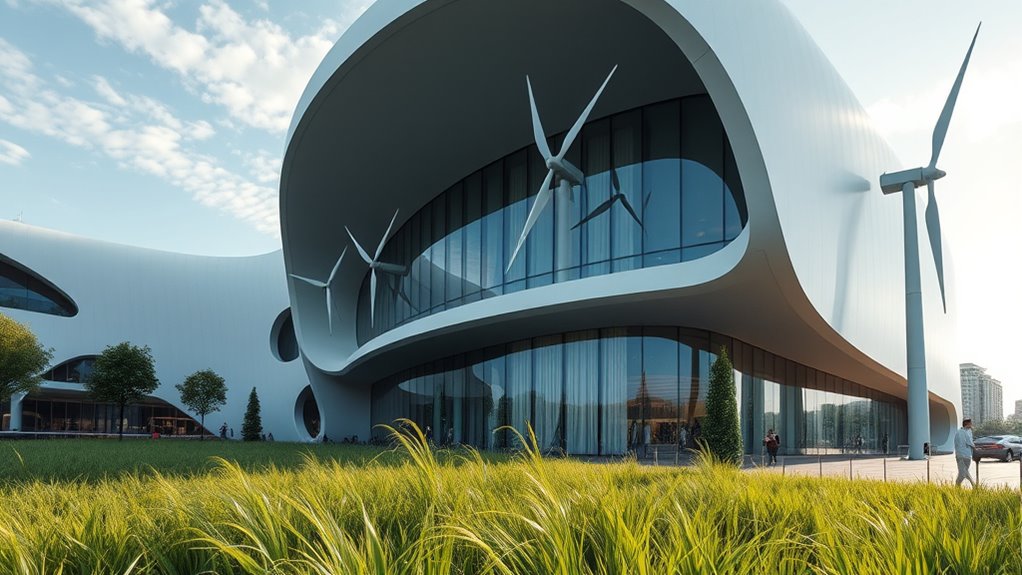
Many successful building designs effectively harness wind effects to improve energy efficiency and occupant comfort. For example, the Bullitt Center in Seattle uses strategic placement of vents and openings to channel prevailing breezes, reducing reliance on mechanical cooling. The Eden Project in the UK employs wind towers that direct gusts into the greenhouse, maintaining ideal temperatures naturally. The Bahrain World Trade Center incorporates integrated wind turbines into its design, generating electricity from passing breezes. These projects demonstrate how thoughtful orientation, ventilation, and structural features can turn wind into an asset rather than a challenge. By studying these examples, you see how leveraging wind effects can lead to sustainable, cost-effective, and comfortable environments. These case studies serve as inspiring models for incorporating wind into your own design solutions.
Frequently Asked Questions
How Can Building Orientation Influence Wind Flow and Comfort?
You can influence wind flow and comfort by carefully choosing your building’s orientation. Position it to face prevailing breezes, allowing natural ventilation and cooling. Avoid aligning walls directly into strong winds, which can cause discomfort and turbulence. Instead, angle or setback the building to redirect airflow smoothly. This strategic orientation helps maximize breezes for ventilation, reduces wind pressure on surfaces, and enhances overall comfort for occupants.
What Role Do Local Topography Changes Play in Wind Behavior?
Local topography changes notably influence wind behavior around your building. Hills, valleys, and slopes can channel, accelerate, or block airflow, creating wind corridors or dead zones. You might notice stronger gusts in valleys or reduced breezes behind ridges. By understanding these features, you can strategically orient your building to optimize natural ventilation, minimize wind discomfort, and enhance overall comfort for occupants.
How Do Seasonal Wind Variations Affect Long-Term Building Performance?
Seasons can change wind speeds by up to 20%, impacting your building’s performance over time. You’ll notice increased wear during stormier months and better airflow in calmer seasons, which affects heating, cooling, and structural integrity. To adapt, incorporate flexible design features like adjustable shading and ventilation systems. By understanding seasonal variations, you can enhance durability, reduce energy costs, and guarantee comfort throughout the year.
Can Wind Effects Be Integrated Into Aesthetic Architectural Design?
Yes, you can integrate wind effects into aesthetic architectural design by creatively using wind-inspired shapes, patterns, and materials. Incorporate flowing curves that mimic breezes, or design open facades that interact with prevailing winds to create dynamic visual effects. You can also use lightweight, translucent materials that sway gently in the wind, adding movement and life to your building’s appearance. This approach blends functionality with beauty, enhancing your structure’s visual appeal.
What Are Cost-Effective Methods for Retrofitting Existing Structures Against Wind?
Retrofitting against wind is surprisingly budget-friendly if you focus on simple fixes like adding storm shutters or reinforcing windows. Installing brackets or braces can stabilize your structure without breaking the bank. You might think these upgrades are costly, but they’re investments that pay off during storms. By prioritizing these cost-effective measures, you turn your home into a resilient fortress, proving that sometimes, the simplest solutions offer the strongest protection.
Conclusion
By understanding wind patterns and incorporating thoughtful design strategies, you can create buildings that harness breezes for comfort and resilience. For example, imagine a coastal home that uses aerodynamic shapes and strategic openings to maximize natural ventilation while resisting gusts. When you prioritize wind-aware design, you not only enhance sustainability and safety but also create inviting, comfortable spaces that adapt seamlessly to their environment. Embrace wind as an asset, not a challenge, in your architectural vision.

